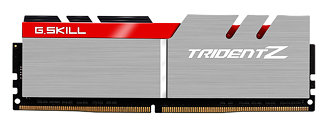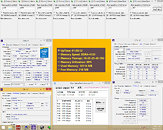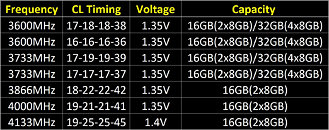Monday, November 23rd 2015

G.SKILL Boosts DDR4 8GB Module Speed Up to 4133MHz 16GB
G.SKILL International Enterprise Co., Ltd., the world's leading manufacturer of extreme performance memory and gaming peripherals, is thrilled to announce a series of ultra high performance DDR4 kits based on 8GB modules, from 3600MHz CL16 32GB (4x8GB) all the way up to the extreme speed of 4133MHz 16GB (2x8GB), featuring ultra-high quality Samsung ICs.
Seeing the growing demand for high capacity memory kit, G.SKILL continually dedicated itself to develop faster memory speed with 8GB DDR4 modules. And all the hard work has finally paid off. Now enthusiasts can experience faster transfer memory speed without compromising capacity. These new high speed DDR4 8GB module-based memory kits will join G.SKILL's latest extreme performance Trident Z family and come with the latest XMP 2.0 overclocking profiles, allowing simple overclocking on compatible systems.Designed for 6th Gen Intel Core Processors & Z170 Platforms
These new high capacity DDR4 kits are designed for the latest 6th Gen Intel Core processors and Z170 chipset platforms with the latest XMP 2.0 profile. The DDR4 4133MHz 16GB (2x8GB) kit has been validated with Intel Core i7-6700K CPU and ASRock Z170 OC Formula motherboard. A stress-testing screenshot of the memory kit can be found below.
Seeing the growing demand for high capacity memory kit, G.SKILL continually dedicated itself to develop faster memory speed with 8GB DDR4 modules. And all the hard work has finally paid off. Now enthusiasts can experience faster transfer memory speed without compromising capacity. These new high speed DDR4 8GB module-based memory kits will join G.SKILL's latest extreme performance Trident Z family and come with the latest XMP 2.0 overclocking profiles, allowing simple overclocking on compatible systems.Designed for 6th Gen Intel Core Processors & Z170 Platforms
These new high capacity DDR4 kits are designed for the latest 6th Gen Intel Core processors and Z170 chipset platforms with the latest XMP 2.0 profile. The DDR4 4133MHz 16GB (2x8GB) kit has been validated with Intel Core i7-6700K CPU and ASRock Z170 OC Formula motherboard. A stress-testing screenshot of the memory kit can be found below.



21 Comments on G.SKILL Boosts DDR4 8GB Module Speed Up to 4133MHz 16GB
TPU guys, can you make a benchmark of different RAM speeds for various tasks like: gaming, video encoding, file compression etc
And make a nice graph how RAM speeds affect performance. Would be a nice and useful article imo.
If time permits, maybe even testing it between quad channel X99 and dual channel Z170 platforms to see if number of channels affects anything.
Speaking of gains...in CPU limited situations faster RAM does help quite a bit. Then again you have to compare the prices. Likely it's cheaper to buy a new CPU to remove the bottleneck rather than buying faster RAM.
Personally i'd rather make a compromise between speed and size. Those 4x8GB kits (32GB) @ 3773 seem nice.
X99 with it's Haswell-based core is much slower than Z170. On X99, there are meager differences from one speed to the next, but on Z170, DDR4-3200 is almost equal to DDR4-2133 on X99 in bandwidth, but with much lower latency. Expect more reviews from me showing this soon.Again, board issue. My X99 Deluxe ran 3000 MHz ram @ 3333 MHz 24/7 without any problems, and many other boards are just as capable.
It's unfortunate that you need to spend a lot of money on both board and ram to have good mem clock scaling, but that's just how it is. Z170 makes this even more evident than X99. I've had 3600 MHz-rated ram since before Z170 launch, and there are still many boards that cannot run those sticks.
Either way, these sticks that the news post is about is 100% designed (researched, binned, mated with PCB, tested) for Z170, and likely will not work with X99. The same applies in reverse; many X99 kits are a bit problematic on Z170, and perhaps because they are utilized differently in the newer Z170 platform.
So for right now, end users should be buying stuff listed in QVLs for each product if using a DDR4 platform. Meanwhile DDR3 is pretty much rock solid at this point.